The Latest News and Views about ANTINOUS the GAY GOD
Compiled and Updated
By
Hernestus, Priest of Antinous

DECEMBER 21st 2009
The Latest News and Views about ANTINOUS the GAY GOD
Compiled and Updated
By
Hernestus, Priest of Antinous


One of the things I love about our religion is that it spans the globe.
Check out the nearly 500 members of the brotherhood of worshippers of Antinous which we call ECCLESIA ANTINOI and you see there are people in South Wales (UK) and New South Wales (Australia). There are people in Sao Paulo and Sydney. There are people in California and Cape Town, and there are some in Portland Oregon and Portland Maine.
For some of us the days are getting shorter and Winter is approaching. For others of us the days are getting longer and Summer is on the way.
For our brothers in Brazil and South Africa and Australia, the jacarandas are in bloom and the days are hot and balmy. Sydneysiders are bracing for another bush fire season.
For our brothers here in Britain and Europe (where I live), the days are short and almost completely sunless and the scent of roasted chestnuts and mulled wine fills the air from vendors on city streets.
For our brothers in the US and Canada, ice storms and the icy fear of economic disaster have put a chill on this Solstice Season.
Wherever we are, regardless of the season, Antinous the Gay God looks into our hearts.
And it is all happening at this magical moment. Twice a year there is a moment ? in fact, a few days ? when the sun seems to "stand still" in the heavens. From the Latin "sol stasis" we derive our name for these events: solstices.
That's the very odd thing about this blue marble upon which we live. The Solstice occurs at the same moment everywhere. But the hands on the clocks point to 23 different hours. And in some places it signals the start of summer (though the days start getting shorter), while in others the it signals the start of winter (though the days start getting longer).
But it is really the same moment and we are all living and breathing at this same moment, though we live in places where the hands of the clock point in all different directions. Each of us is alone. All of us are together in this aloneness.

It is the moment of Antinous-Narcissus. And this is the cue for Arch Priest Antonius Subia to wax eloquent about the Antinous Mystery Teachings revolving about the phenomenon of the December Solstice. It is the Three-Fold Mystery Teaching about how the Lone One begets the Three-Fold Divinity:
"The return of the sun is the Conquest of Unconquered Light over chaos and darkness, the emergence of Phanes-Eros-Dionysus from the cosmic egg. On this day, we observe the moment when the unknown god Bythus-Narcissus gazed into the pool of the abyss and saw his own reflection. His image caused the birth of the thrice-great Phanes-Eros-Zagreus, the saviors, who together are called Antinous Invictus. The three-fold mystery of their birth is the descent of Phanes-Beauty, Eros-Love and Zagreus-Ecstasy into our world. These great spirits are the divine light of Antinous the God, it is their presence at the ground of our soul that is our immortal spark. Within us all is the perfect image of the perfect face of light and love, a reflection of Narcissus-Bythus gazing down into the darkness of our world."
And then, Antonius Subia goes on to tell us, the ONE who begets the THREE, then becomes the MANY ....
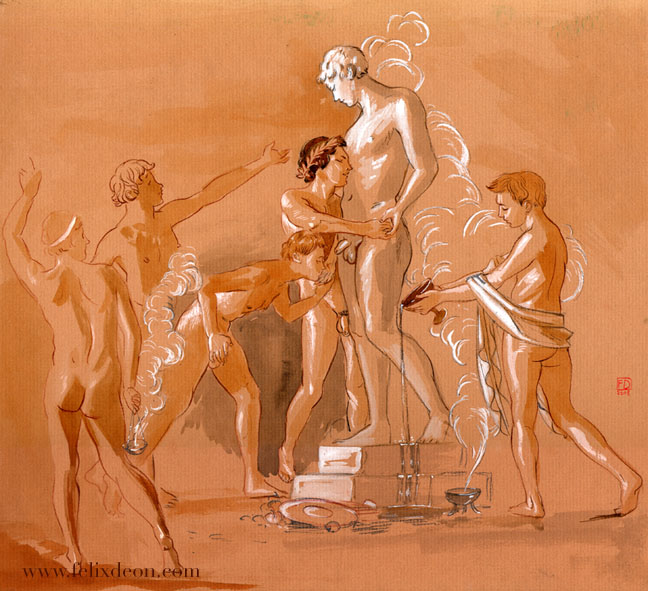
"In celebration of the return of Antinous Invictus, for the five days between December 25th and the 1st of January, we commemorate the Golden Age of the reign of Saturn. This is a time outside of time, and an occasion for joy and freedom from the world. The divine twins are born, Osiris and Isis, Set and Nephthys, Castor and Pollux, Freyr and Freya (for whom this time is also known as Yule). We celebrate the Saturnalia with indulgence and as the festival of Liberty and total Freedom. There shall be no authority and no submission during this sacred period. There is to be no war, and no form of violence committed, only peace and harmony and the many joys of ecstasy are allowed. The rejoicing of the Saturnalia ends when the Prince of Flowers, Aelius Caesar, dies at midnight on December 31st."
It starts with the December Solstice.
Our brothers are scattered across all seven continents. They come from all racial and ethnic backgrounds. They come from all walks of life.
Some are well off while others live in grinding poverty. Some are successful both in terms of material wealth and in love. Others lead lives of quiet despair.
Some are blessed with youth and health.
Others wonder whether they will live to see the seasons change again.
For some of our brothers it is the Shortest Day of the Year. For others it is the Longest Day of the Year. It is the Winter Solstice but it is also the Summer Solstice.
It is the same moment. And it is all moments. It is Winter. And it is Summer. It is Sunlight and Life. And it is Darkness and Death.
It is the Cycle of the Seasons. Change is the one constant in life on this blue marble. Change is the one constant in our lives. The dawn always follows the night. Spring and Summer always follow Autumn and Winter.
Just as the Earth turns and the Seasons turn, our lives are also perpetually turning. If we stop turning, we die. It is only through turning that we live. Letting yourself just turn with life is one of those "Simple Gifts" that the old Shaker hymn so beautifully expresses:
The Constellation of Antinous "died" in late October when the constellation merged with the sunset ? just as Antinous himself died in late October. Hidden by the glare of the sun, it is not visible during the December Solstice. But the Constellation of Antinous will surely emerge from the sunrise a couple of months from now and will begin its ascent into the skies, reaching its pinnacle exactly six months from now ? at the time of year called Summer in some places, and called Winter in other places.
It is the same phenomenon. But how you see it depends on how you look at it.
The days are getting longer. The days are getting shorter. It all depends on how you look at it.
However you look at it, remember that we are all brothers, lovers and comrades. And we are all turning, turning toward our own true delight.

MAGINATION is the key word. Just imagine the cramped artist's studio in London's Chelsea district and, with the help of the artist's images, you are there. It is December 1909, exactly 100 years ago. The solid-black walls of the apartment contrast starkly with the red-orange drapes. Jamaican folk artefacts share space on a Victorian curio shelf with photographs of friends and relatives ? a mother in Jamaica, a father in Brooklyn Heights, a famous actress in a West End production, Bram Stoker, W.B. Yeats. The jet-black walls form a void-like exhibition space which highlights the dazzling Caribbean art as well as the dozens of paintings and sketches which line the walls. Suffragette posters. Oil landscapes. But particularly watercolor illustrations of dreamscapes and fairy tales.
A brightly painted miniature theatre with ornate proscenium and cloth curtain stands proudly in one corner, with its cast of tiny cardboard cut-out "actors" waiting patiently for their entrances.
An enormous gramophone stands in the opposite corner, and Debussy's La Mer is playing at full volume, as it has been all morning. The neighbours have long since stopped complaining about the music.

The artist, Pamela Colman Smith, is a petite woman in her early 30s who sits in the middle of the studio with paint brush in hand, mixing watercolors, her eyes trance-like as the music envelops her. She is wearing a vividly hued kimono with broad sleeves made even more colorful by splotches of paint.
One of the two Japanese combs pinning back her long dark hair has loosened, causing her tresses to sag to one side, but she is oblivious. The paint is dripping from her brush, but she pays no mind, keeping her eyes firmly shut as Debussy transports her to a place she calls "the unknown country" of her artistic inner heart.
On the easel in front of her is a small canvas showing an androgynous person wearing a short kimono-like tunic with sleeves and an abstract floral design uncannily like the kimono she is wearing. The figure is striding to a precipice as a small white animal dances at his heels.
The painting is almost finished. The outline was done in pen. Only a few more brush strokes are needed for the hand-coloring. Debussy will provide the musical sunrise which will be the cue that the illustration is finished.
And then the small illustration will join all the others (about 80 in all, give or take one or two) which are carefully arranged on drying shelves around the studio. The printer is waiting. The cards must be delivered by the end of December.

She has been working on the Tarot card project for about a year, since Arthur E.A. Waite asked her to illustrate "his" new pack of Tarot cards in his long-running one-upsmanship feud with other occultists in London. He had very strong ideas about the design of the 22 Greater Trumps but was unconcerned with the 56 Lesser Trumps. Only one other artist had ever illustrated all 78 cards, an unknown 15th Century artist whose dazzling cards were jealously guarded by the Sola Busca family of Italy. The Sola Buscas had grudgingly permitted photographic copies of the cards to be put on view at the British Museum in 1908.
And so it was, that a petite 30-something sufragette took a tweedy advertising executive for the Horlick's bedtime powdered milk drink (Waite's "day job" when he wasn't doing occult spellwork) and dragged him to the British Museum and said she would do the job but only on condition that she illustrate all 78 cards with artistic license for design and color.
It had taken months of pain-staking work. "A big job for very little cash!" she would write to her friend and benefactor Alfred Stieglitz, who had made room in his famed New York photography gallery for exhibitions of some of her "Pictures in Music", watercolors she painted in a trance-like state while listening to her favorite composers, such as Mozart, Tchaikovsky and Debussy. On a visit to Paris, she had even been bold enough to introduce herself to Debussy and show him paintings she had done to his music. She was greatly flattered when he said she had captured the very essence of his music.

"You ask me how these pictures are evolved," she said. "They are not the music theme ? pictures of the flying notes ? not conscious illustrations of the name given to a piece of music, but just what I see when I hear music-thoughts loosened and set free by the spell of the sound."
She explained that, for example, "Often when I hear Bach I hear bells ringing in the sky, rung by whirling cords held in the hands of maidens dressed in brown."
Stieglitz had shown her music paintings to rave reviews in New York in 1907. The New York Sun critic wrote: "Pamela Colman Smith is a young woman with the quality rare in either sex ? imagination."
Pamela ? "Pixie" to her few close friends (mostly women) ? had grown up in London and New York City, as well as in Jamaica. Her father was a globe-trotting businessman who spent little time at home. Her mother came from a long line of women poets and children's story-book writers. The details of her childhood are fuzzy. She had a dark complexion and facial features which prompted speculation that she had been adopted during her father's many trips to Jamaica. At any rate, she spent her formative years in Jamaica, where she learned the patois dialect perfectly and became a master story-teller of Jamaican tales of magic and wonder.
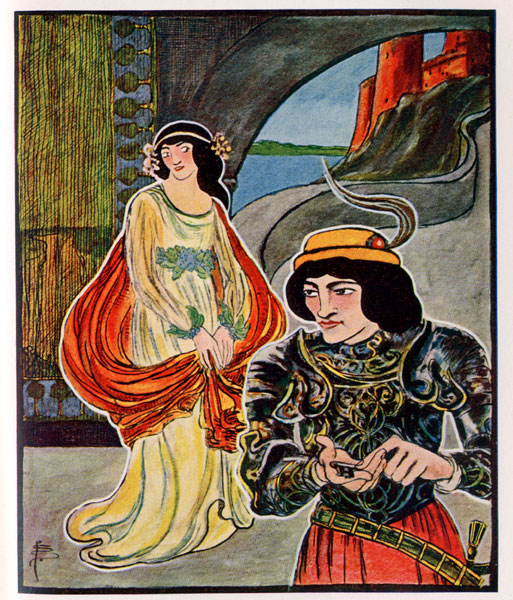
But when her mother died at an early age, little Pixie moved to Brooklyn Heights where she lived with her father and pursued art classes at the renowned Pratt Institute, a progressive school which encouraged students to explore new avenues of expression.
And when her father also died suddenly, she was shipped back to England to live with a troupe of actors who were friends of her eccentric father. She was relieved to be back in England, since her skin color had exposed her to racist discrimination in the States.
The rarified atmosphere of London's Leicester Square theatre district was an invigorating change. In New York she had been "a mulatto". In London's West End she was simply exotic. She lived with the high-profile actress Ellen Terry, who became her mother, mentor and best friend. Sir Henry Irving, a leading thespian and empresario, became her ersatz father. The three of them toured Britain in productions when they weren't staging their own plays in the West End. Pixie lived in Irving's theatre. She learned set design, costume design (and how to mend costumes between acts) and she learned how the stage is the world-in-small.
A century on, it is hard for us to appreciate how mind-opening the theatre was. There was no radio, no television. Even the cinema was in its infancy. To see the world, you went to the theatre. Pamela didn't just go to the theatre. Surrounded by actors and directors 24 hours a day, she truly LIVED the theatre. She said it was the perfect place for a budding artist.

"Go and see all the plays you can," she advised young artists. "For the stage is a great school ? or should be ? to the illustrator ? as well as to others."
She openly admitted she had learned more in the theatre than at her famous New York art institute.
"The stage has taught me almost all I know of clothes, of action and of pictorial gestures," she said, and her advice to other artists was to throw away the textbook and just open their eyes and ears. An artist should always have a sketch pad at hand. She even took her sketch pad to the ballet to see Nijinsky dance.
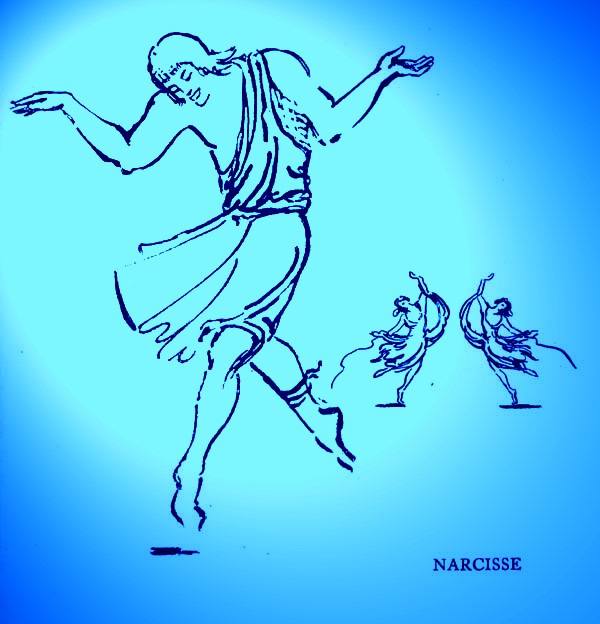
"Learn from everything, see everything, and above all feel everything! And make other people when they look at your drawing feel it too!"
She was dismissive of painters who are interested only in their medium and who shun other liberal arts.
"Keep an open mind to all things," she said. Even though you are a painter, listen to music, go to the ballet.
"Hear all the music you can, for sound and form are more closely related than we know."
And she dismissed turn-of-the-century painters who strove only for beauty, ignoring ugliness.
"For through ugliness is beauty sometimes found," she observed. She recalled having seen a very dark and brutal stage production which in a way reminded her of the gritty beauty of poverty-stricken Jamaica.
"All through that play I thought that ugly things may be true to nature, but surely it is through evil, that we realize good. The far-off scent of morning air, the blue mountains, the sunshine, the flowers, of a country I once lived in, seemed to rise before me ? and there on the stage was a woman sitting on a chair, her body stiff, her eyes rolling, a wonderfully realistic picture of a fit."
Through Ellen Terry and Henry Irving, Pamela made friends with literary luminaries such as "Dracula" author Bram Stoker, "Peter Pan" playwright J.M. Barrie and and poet/playwright W.B. Yeats.
In fact, "Sherlock Holmes" was her uncle ? because her real-life great uncle was the actor William Gillette, who brought Holmes to the stage in London and on Broadway. It was Gillette who introduced many of the mannerisms and props (the deerslayer cap, the meerschaum pipe) which have been intrinsically associated with Sherlock Holmes by succeeding generations. Her Uncle Bill even saw to it that Pamela illustrated the programs for his Holmes productions.
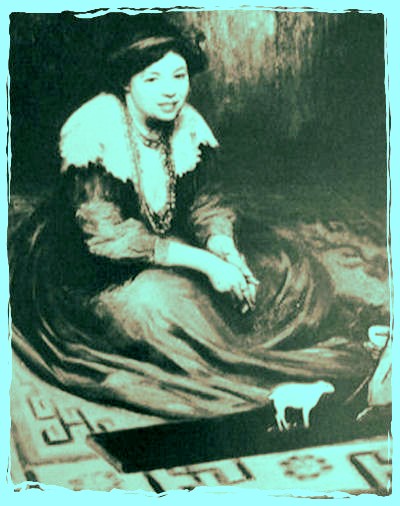
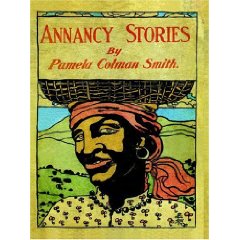
Pamela became well-known for her afternoon literary teas, at which Yeats, Stoker and other luminaries would gather in her studio while she put on the costume of a Jamaican wise woman and sat cross-legged on the floor, relating Jamaican folk tales in dialect.
She used a miniature theatre and tiny cardboard characters to illustrate her hugely delightful tales.
Her literary friends encouraged her to publish and illustrate the stories under her own name, which she did. The book is still in print.
One frequent male visitor described one such literary evening, saying, "The door was flung open, and we saw a little round woman, scarcely more than a girl, standing in the threshold. She looked as if she had been the same age all her life, and would be so to the end. She was dressed in an orange-colored coat that hung loose over a green skirt, with black tassles sewn all around over the orange silk, like the frills on a Red Indian's trousers. She welcomed us with a little shriek. She was very dark, and not thin, and when she smiled, with a smile that was peculiarly infectious, her twinkling gypsy eyes seemed to vanish altoghether. Just now, at the door they were the eyes of a joyous, excited child."
This was shortly after the turn of the 20th Century, and she had perfected her artistic style and was busy as a book and magazine illustrator. While publishers mandated style to some extent, Pamela Colman Smith advocated the Arts and Crafts style, also known as the Secession style or, in the US, as the Craftsman or, especially in California, called the Mission style.
The Arts and Crafts Movement was a style which dominated in the years before World War I, and which was between the Art Nouveau style of the 1890s and the Expressionist style which would revolutionize art after the Great War. The Arts and Crafts Movement was an attempt to reject superfluous Victorian "wedding cake" adornment and to simplify things to the basics of simple lines and solid colors, in defiance of bourgeouis homeowners who wanted clutter.
For one brief moment, in the cosy years before the war, idealistic artists such as Pamela depicted a magical world in which machines did not dominate humankind. They were artists who sought to recreate pre-industrial, even primitive styles in art, architecture and decoration. Lines were simple. Colors were bold and earthy.

Pamela's generation of artists saw that a world driven by steam pistons was heading blindly, full-steam ahead for collision with the cold and immutable forces of nature. The Titanic disaster in 1912 was only a symbolic inevitable disaster waiting to happen, as far as these artists were concerned.
The Arts and Crafts Movement flourished in the first decade of the 20th Century, and Pamela managed to get by financially with her illustrations in that style. She also provided illustrations and even wrote articles for Gustav Stickley's "The Craftsman" magazine which was a leading purveyor of the style.
Not surprisingly, her Tarot cards are an enduring monument to the Arts and Crafts Movement and its philosophy which holds that a return to timeless styles in the Arts can help the human race return to timeless virtues and ageless wisdom. She was seeking to create a world in which racist thought and moral hypocrisy would vanish along with high-button shoes and celluloid shirt collars. She wanted everyone to sit on the floor, cross-legged, and discover the childlike magic of just being alive.
The cards were published with very little fanfare in December 1909. Only a few occultists took notice, and most of them were engaged in feuds with each other. The general public did not notice. Tarot cards were considered to be "French". The only Tarot cards hitherto available were from France, and they were considered only slightly less objectionable than saucy French porn postcards. Pamela was keenly aware that her cards were not going to make inroads into popular culture.

"Oh, the prudishness and pompous falseness of a great mass of intelligent people!" she wrote in an article for Stickley's "The Craftsman". It was an article aimed at inspiring young artists. "Lift up your ideals, you weaklings, and force a way out of that thunderous clamor of the steam piston, the hurrying herd of blind humanity, noise, dust, strife, seething toil!"

Those 78 cards are a veritable map of the place which she called "the unknown country" within an artist's heart. Many of her book illustrations are variations on that theme, such as "The Hill of Heart's Desire" at left.
To look at each card in succession is to take a trip through a magical land where cosmic wisdom and virtue prevail. You can spot recurring landmarks, such as castles, bridges and towers, which recur from different vantage points throughout the "journey". This magical land is peopled by beings who at times wear Renaissance clothing and at other times wear chitons and togas. The whole magical world is a place beyond linear time and space.
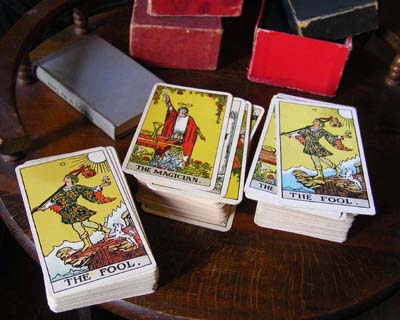
Waite never adequately acknowledged her work. In the book accompanying the cards he failed to mention her by name, saying only that a "young woman artist" had illustrated them on his instructions. But in fact, Pamela had been a member of the Order of the Golden Dawn along with Stoker and Waite. In a way it was only natural since the English-speaking world's first esoteric book store, Watkins, had just opened its doors a few steps away from the Leicester Square theatre district.
Pamela never wrote about her initiation into occult mysteries. But the very first card in the deck, The Magician, is graphic proof that she was privy to occult knowledge of the most secret sort. In 1909 only a handful of people had read a badly translated copy of Das Buch Abramelin, a 15th Century German-language grimoire written by a German-Jewish sorcerer who claimed to have been initiated into ancient mysteries by a master living in a desert cave on the banks of the Nile.
Even now, a century after Pamela painted that card, very few people have read the Book of Abramelin, certainly not in the original German. To this day there is no full English translation. Those few who have read it immediately realize that The Magician card is a very precise portrait taken straight from the ancient book.
In it, the novice magician is instructed to wear a clean white tunic bound at the waist by a symbolic ouroboros serpent. He is to wear a crimson mantle over the tunic while standing before a simple wooden table upon which are his magical tools. The book then says that, for best results, the magician's magical work space should look out over a witch's garden of flowers and magical herbs.
Whatever Waite thought of "his" cards ? and he was very vague in saying what their purpose should be other than clearly to aggrandize himself ? Pamela knew they were tools not for TELLING the future, but for SHAPING the future through ancient Abramelin magical spells. That occult secret, sealed in the colorful symbolism of her cards, was destined to die with her ? to be rediscovered a century after she created the cards by priests of ANTINOUS THE GAY GOD.

With that first card, The Magician, and with Renaissance alchemical symbolism throughout the deck, Pamela shows she was highly knowledgeable in the occult arts.
The rest of her story is quickly told. The Titanic sank but the age of the steam pistons did not go down with it. Instead, the First World War swept aside the lofty dreams of Pamela's generation of artists. The Arts and Crafts Movement was the first casualty. By 1915 Gustav Stickley's "The Craftsman" magazine ceased publication and his design company went bankrupt.
Pamela's illustration assignments dried up. By the mid-1920s she was unable to get even one job a year. When a distant uncle died and left her a modest nest egg, she took the money and left London, buying a village cottage at the far western tip of England ? not far, in fact, from the fictional location of Baskerville Hall, which had figured so prominently in Uncle Bill's Broadway-hit Sherlock Holmes plays.
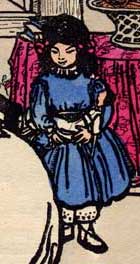
She lived in isolation with a woman companion. She died penniless at age 72 on September 18, 1951. The cottage and all her possessions were auctioned to pay back taxes, leaving her companion with nothing.
In December 1909 she had told her New York gallerista friend Alfred Stieglitz that she would send him a pack of the Tarot cards which she said were being "printed in color lithography (probably very badly) as soon as they are ready" and that she would also "send over some of the original drawings as some people MAY like them." By "some people", she meant "buyers". But the original art work has never surfaced. Not one of the 78 originals is known to exist.
The printed card decks vanished into obscurity for decades until the American playing card connoisseur Stuart R. Kaplan resurrected them in about 1970. It is largely thanks to him that anyone knows anything about this extraordinary artist, who created a single work which is ageless and timeless and which continues to appeal to new generations.
The final word belongs to Pamela Colman Smith, and it is a statement of inner strength which could just as easily be the catch-phrase of The Fool card in her Tarot:
"Banish fear, brace your courage, place your ideals high up with the sun, away from the dirt and squalor and ugliness around you and let that power that makes the 'roar of the high-power pistons' enter into your work ? energy ? courage ? life ? love. Use your wits. Use your eyes. Perhaps you use your physical eyes too much and only see the mask. Find eyes within, look for the door into the unknown country."

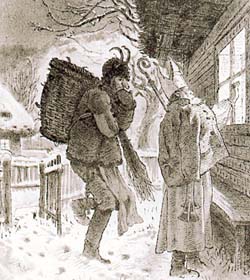
Those of you who are real card-carrying pagans probably know that today, December 5th, is the day in many parts of Central Europe when Santa's Dark Helpers are honored. Tomorrow, December 6th, is the Feast Day of St. Nicholas and it is the day when kiddies put out shoes or hang up stockings (the traditions vary from country to country) to receive gifts from Old St. Nick. That is when Santa rewards the children who have been nice all year.
St. Nicholas was born in the Asia Minor port town of Patara (modern Myra, Turkey), which had a renowned oracle at a temple of Apollo which, it is said, Bishop Nicholas tore down and replaced with the church which bears his name today. Patara was also one of the purported birthplaces of Apollo. St. Nicholas was never officially canonized by the Church. He simply usurped the popularity of Apollo and promoted his own reputation for being a protector and a giver of good things.
Throughout Eastern and Central Europe, customs dating back to Antinous/Apollo are mixed with Christian traditions. Cernunnos and Apollo still live in these folk customs. So it is that December 5th is the day when Santa's Dark Helpers roam the streets looking for naughty children who need to be punished.
In the English-speaking countries, we combined Santa and his helpers (the elves and reindeer) into a composite which arrives at Christmas time to stuff the stockings and reward children who have been naughty and nice.
But the pagan history shows that St. Nicholas is a vastly more complex being, stemming from the Temples of Apollo and Artemis in Asia Minor (the birth country of Antinous) which would later be the birthplace of the historical Nicholas.
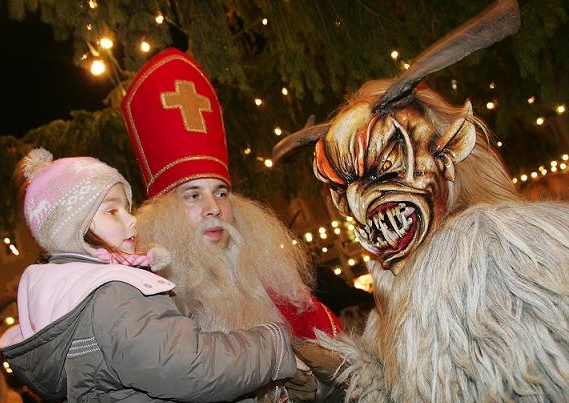
In many places in the Alps and in Central European countries such as Austria, Hungary, northern Italy, the Czech Republic and Germany, this Yuletide spirit being is a duality. Part of him is the kindly priest in flowing robes and part of him is the fiend with slashing teeth and claws.
Even schoolboys learn early on the fun of dressing up as Krampus. It really is the Central European equivalent of Halloween, and teenage boys "become" demons at this time of year.
On December 5th, it is the Christmas "fiend" or "demon" which prowls streets looking for unwary children to pester. In Holland he is called Svartze Piet (Black Pete or Black Boy) and he has other names in other countries. In Germany he is Knave Ruprecht. Most places he is called Krampus pronounced "KRAHM-POOSE".
And what Krampus does is all kind of a combination of Halloween Trick-'R'-Treat and Christmas caroling -- all of which are closely related ancient pagan customs.
In a kind of Yuletide Halloween, young men dress up in Krampus outfits. The costumes vary from one Alpine valley to the next. But generally they consist of fur pelts, Cernunnos-like horns and numerous cow bells, whips and chains. A werewolf-style mask has become popular in recent years, though Krampuses in earlier times made do with sooty faces.
Fueled by alcohol or other "Christmas spirits" (to ward off the cold, you see), these young men magically take on the personality of Krampus -- they roam the streets about sundown frightening children and demanding drinks from the neighbors. In larger cities there are proper Krampus parades down the main thoroughfare in the middle of town. But big town or little village, a procession of Krampus kritters is very intimidating even to grownups, not to mention small dogs, like this one in Arnold Schwarzenegger's hometown of Graz, Austria:
Whips, chains, birch switches and cow bells create a cacophany which echoes through the narrow streets. Add to that the aroma of roasted chestnuts and mulled spiced wine and you have a recipe for pagan merriment which bears only a passing resemblance to what most non-Europeans would call Christmas:

Alcoholic beverages, gingerbread, chocolate fondue and all sorts of baked goods are all part of the fun. For people in the Alps, the Yuletide season wouldn't be the same without a chocolate St. Nicholas AND a chocolate Krampus to go with him.

Krampus is a big merchandising gimmick. Alpine bakeries make Krampus turnovers in the shape of a horned demon and which are stuffed with delicious sweet mincemeat filling. Street vendors sell figgy-prune Krampus figures -- confections made of dried prunes and figs and nuts which are strung together onto wires so that they stand upright. I've seen some of these figgy-prune Krampus figures that were almost a meter tall (with coconuts for heads) and which were used as window displays in department stores in Austrian cities. A candy Krampus as tall as a man in a confectioner's window in Vienna was made entirely of pink spun sugar.
Later on the evening of December 5th, when all good boys and girls are snug in bed, Krampus and his cohorts go on a drunken rampage of attacking people with burning torches. They run in packs through the streets of small Alpine towns, attacking "naughty" children and any woman who ventures out and of course they really get rough with other males:
Then on December 6th, St. Nicholas takes things firmly in hand and the horned Krampus cohorts serve as his escorts as they go from door to door in small villages playing a kind of Trick-'R'-Treat. Nice children get some candy from St. Nick and naughty children get chased around the living room by Krampus:
In many places, several different aspects of Santa process all together. St. Nicholas is joined by Christkindl (Kriss Kringle in English) who is an androgynous Apollo-like figure wearing snow-white robes and a gold crown -- and followed up by Krampus along with various angels and demons.
As Sacred Synchronicity would have it, I just got an email asking if it's true that Apollo and Cernunnos and Santa Claus are all related. Oh yes! It's too true!
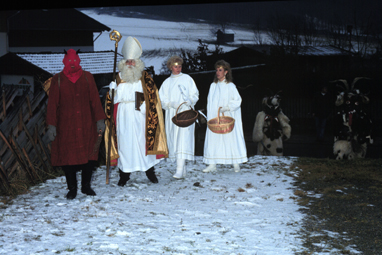
St. Nicholas was born in the Asia Minor port town of Patara, which had a renowned oracle at a temple of Apollo which alas no trace of which has been found. As I mentioned, Patara was also the birthplace of Apollo, or at least of his son Patarus by a water nymph called Lycia, from whom the whole region got its name -- Lycia.
The Patara Oracle was active in winter, when Apollo preferred the climate of the Turquoise Coast. In summer, Apollo moved back to Delphi.
In 245 AD Patara saw the birth of a boy called Nicholas, who anonymously gave his inherited wealth to needy children. St. Nicholas grew up and moved to the nearby town of Myra, which had a curious fish oracle devoted to Apollo.
According to Pliny:
"At Myra in Lycia at the fountain of Apollo whom they call Surius, the fish, summoned three times on a pipe, come to give their augury. If they tear the pieces of meat thrown to them, this is good for the client, if they wave it away with their tails, it is bad."
Atheanaios reports on the ceremony:
"I don't want to ignore the people of Lycia who know the art of the fish oracle. Of them, Polycharmus writes in the second book of his Lycian history. '...when they come to the sea, where is the grove of Apollo by the shore, on which is the whirlpool in the sand, the clients present themselves holding two wooden spits, on each of which are ten pieces of roast meat. The priest takes his seat in silence by the grove, while the client throws the spits into the whirlpool and watches what happens. After the spits are thrown, the pool fills with seawater, and a multitude of fish appear as if by magic, and of a size to cause alarm. The prophet announces the species of the fish and the client accordingly receives his answer from the priest. Among the fish there appear sea bass and bluefish and sometimes whales and sawfish and many strange and unknown kinds."
Plutarch and Artemidorus also offer similar accounts of the fish oracle ceremonies at the Apollo Surius temple.

Apollo's sister Artemis also had a cult center in Myra. Myra's main cult was dedicated to Artemis Eleuthera, a distinctive form of Cybele, the ancient mother-goddess of Anatolia. She had a magnificent temple in Myra.
Unfortunately, St. Nicholas, the bishop of Myra, was zealous in his duties as bishop and took strong measures against paganism. The temple of Artemis and the Apollo oracle were among many other temples in the region that he destroyed. It is said that the very foundations were uprooted from the ground, so complete was its destruction, "and the evil spirits fled howling before him".
St. Nicholas was never officially canonized by the Church. He simply usurped the popularity of Artemis and Apollo and promoted his own reputation for being a protector and a giver of good things. Antinous/Apollo more or less morphed into Old St. Nick, aka Santa Claus, Father Christmas, das Christkind and Kriss Kringle.
Supposedly he saved three young women from having to prostitute themselves by dropping bags of money anonymously through their window while they slept. In another version, three little boys had been killed by a pedophile innkeeper who dismembered their bodies and served them in a stew to his guests. Nicholas stopped by the inn, took one taste of the Three Boy Stew and instantly let out a cry to heaven which caused the boys to be restored to life intact right there on the spot.
There are numerous other stories about fish and boats and children being saved and also about thieves. Like Antinous/Hermes, St. Nicholas is the patron saint of thieves. He is the saint of prisoners, cut-throats and con men because he saved three convicted armed robbers from being executed.

The stories generally involve the number three and miraculous rescues and gifts given surreptitiously after fall of darkness.
So Antinous/Apollo, in the guise of Nicholas, later became Bishop of Myra and was respected for his humane approach to religion and as a protector of children and fishermen. He is still known as St Nick, Santa Claus, Sinter Klaas, das Christkind or Kriss Kringle. And in a lot of places, Santa has several dark and scary sidekicks.
They are all aspects of the composite spirit being who in English-speaking countries is called Santa Claus or Father Christmas. But the deeper you go back into Central Europe, the more differentiated this ancient being becomes so that you see his various component parts -- including Antinous-Apollo.
In the Nordic and English version, of course, all that is left of Krampus with his horns and hooves and fur is the reindeer which accompany Santa's sleigh.
Next time you see a department store Santa, just remember you are seeing only a composite being whose multitudinous composite aspects (many of them very dark and spooky) trace their origins back to the beginnings of mankind. If you look very, very carefully, you will see the face of Antinous/Apollo shining through the centuries of folk customs.

The Religion of Antinous has many solemn holidays such as the Death of Antinous. But we also have the Birth of Antinous which we celebrate on November 27, which this year almost exactly coincides with Thanksgiving Day in the US, so you can count on having a day off from work on Friday to celebrate the Birth of Antinous.
November marks the start of the ancient pagan Festive Season, a season which is still full of fabulous party dates -- including Christmas, New Year's Eve, Twelfth Night and of course American Thanksgiving. Dia de los Muertos and Halloween usher in this Festive Season of twinkly lights and over-eating and drinking way too much.
These ancient festivities go back WAAAAY before Christianity, of course. So it's a safe bet that Hadrian and Antinous would recognize many of the features of these festivities
So when you plan your Antinous Birthday Party, you can mix-and-match customs from all sorts of pagan Festive Season holidays, in full knowledge that Hadrian and Antinous would nod in approval.
Here's how I envision the Birthday of Antinous:
It should be celebrated with feasting and drinking and singing and carousing. Pine boughs should decorate the feast room in honour of the pine forests of Bithynia, the highlands of modern-day Turkey where Antinous was born. Electric lights should be turned off in favor of candlelight or at the very least those strings of tiny "fairy lights" which Moslems use during Ramadan and Hindus during Divali and Christians at Christmas
The one really bright spot in the room should be a bust or image of Antinous, which is spotlighted, signifying our belief that Antinous brings light into the world.
The Antinous Red Lotus would be perfect. But since not everyone has access to lotus blossoms in late November, orchids would also be fine. The orchid takes its name from the Greek word "orchis" which means "little boy's testes" for obvious reasons:

Hadrian and Antinous would have known this. Antinous would have seen wild orchids in the piney woods of Bithynia as a boy
Orchids would be lovely as well as being a Hellenistic conversation piece. If they are too pricey, then your favorite seasonal flower will do. Look around and find something that is beautiful and unique to your own locale which you think would be very nice.
The Birthday of Antinous would be a wonderful opportunity for a costume party, also in keeping with the Halloween/Carnaval/Christmas flavor of these ancient pagan holidays. Guests might be encouraged to come as Greco-Romans or Egyptian priests.
The menu could be Mediterranean, with lots of finger foods such as tahini and couscous and humous and pita bread, stuffed olives, eggplant/aubergine, goat's cheese and so on. Refried beans (which the Egyptians call "fuul" and eat for breakfast) would be ideal since the theory goes that the Moors introduced "fuul" to the Spaniards, who introduced it to the New World.
But you should feel free to go local with favorite regional dishes of your home area. There must be lots of good Cajun dishes which would be perfect, or Scottish specialties, or Aussie barbecued prawns or New England pot pies -- good simple "plebeian" food which is festive and spicy and filling.
In keeping with these pagan festivals, foods should represent birth and regeneration: beans, peas, black-eyed peas, pumpkins, squash, nuts, berries.
It doesn't really matter what food is served, of course, as long as it's delicious and plentiful, and as long as there is plenty of drink to wash it down, wine or beer or just good old iced tea.

Beer is quite appropriate, since the Ancient Egyptians were brewing beer thousands of years before Antinous was born. The Egyptians still produce a very nice light lager called Stella beer which has the advantage of having a star on its label reminiscent of the STAR OF ANTINOUS.
Just imagine: Antinous' last meal may have been refried beans and beer and flat bread.
You think I'm joking, but when celebrating the Birth of Antinous, I think we should be creative and try to think of what he would might have enjoyed eating and drinking.
Here's a very good idea, if I do say so:
In a change from holiday cakes and cookies, how about baking Antinous cookies? Bake simple sugar cookies which have been cut out to resemble stars, comets, an imperial crown and Bithynian fir trees and lions and so on and decorate them with Antinoian lettering or symbols.
Instead of gingerbread men, make gingerbread Antinouses. The gingerbread man, after all, is thought to come from pagan rituals for honoring Thor or other gods. Generally, they are sweet dough which is filled with a nut-date-spice filling representing rebirth and spiritual sustenance. You still find them today on St. Nicholas' feast day throughout Europe.
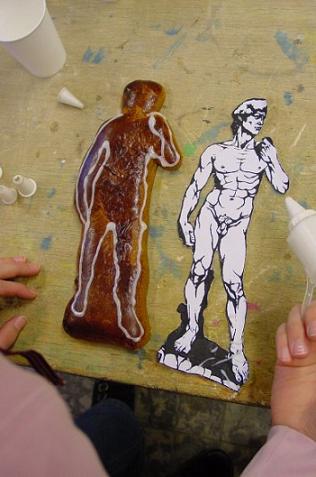
Or how about an Antinous Birthday Cake? Just look at one of Antonyus Subia's medallions and you have the ideal pattern for icing a really wonderful cake.
Whatever you bake, make sure to include a small "surprise" somewhere in the cake or muffin or cookes for some lucky guest to chomp down on. It doesn't have to be a diamond ring, but a trinket of some sort is always fun. And the risk of chipping a tooth or gagging on a sharp object invariably adds to the merriment of the evening. If that is too challenging for your skills as a confectioner, then just an ordinary cake with the letters "A-N-T-I-N-O-U-S" in store-bought candy lettering would do the job just as nicely. Or just a large "A" in icing in the middle of the cake. Even I might be able to manage that.
Another tradition should be oracle games. This is the first major festival of the New Year in the Antinoian liturgical calendar, so oracles are appropriate. Here in Europe (where I now live) there's a lead oracle game which is a tradition on New Year's Eve. It costs very little. You buy a kit with about half a dozen pellets of lead and a cheap spoon.
Everybody is seated around a table in the center of which is a bowl of water. Each party guest gets one lead pellet. One after another, the guests place their pellet in the spoon and hold it over a candle flame until the lead melts. Then the guest pours the molten lead into the water, where it instantly cools in a cloud of fizzing steam.
Afterwards you retrieve the cooled-off clump of lead and attempt to decipher the "occult" meaning in its twisted form.
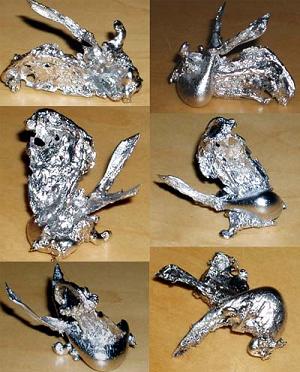
You can't imagine how thrilling it is to have a bunch of tipsy guests slinging spoonfuls of molten lead around a dinner table decorated with dozens of blazing candles and tinder-dry pine boughs. You don't have to have an oracle to foresee that the evening is fraught with all sorts of possibilities.
You think I'm being sarcastic. I'm not. I sincerely believe the Birthday of Antinous should be a pagan holiday which combines the best pagan traditions for fun and merriment, traditions for sharing food and love.
And when your guests suggest you are robbing traditions from Christian festivals, just look them square in the eye and insist that the Christians stole these wonderful traditions from us pagans because the Christians didn't have any of their own. Where would Christian holidays be without pagan traditions?
Who knows? Perhaps Hadrian and Antinous enjoyed these very same pagan traditions in their Saturnalia revelries.
Oh, one more thing: Mistletoe. Mistletoe is plentiful in the forests of Bithynia. Antinous would be well familiar with mistletoe. I'm sure he would like it as a reminder of his boyhood hikes through the woods of home.
Use your imagination and you'll come up with lots of ideas.
Let the Festive Season Begin with an Antinous Birthday Party!

HOLLYWOOD ? Gay icon Judy Garland was sanctified as a saint of ANTINOUS THE GAY GOD in ceremonies in Hollywood on October 30th which culminated a week of events.
"By sanctifying Judy, we elevate her to the sacred status she deserves as someone who has inspired and enlightened millions of gay people around the world," said Antonyus Subia, arch priest of the Hollywood Temple of Antinous, in announcing Garland's sainthood.
"It was her tragic death on June 22, 1969 ? 40 years ago this year ? which fueled the fires of revolution which ignited into full flame during the Stonewall Riots after her funeral in New York City," Subia explained.
Other gay icons who were sanctified along with Judy Garland in the solemn ceremonies at the Hollywood Temple of Antinous were Danish fairy tale author Hans Christian Andersen, the 300-pound drag queen Divine and British computer-sciences pioneer Alan Turing, Subia said.
Andersen, a lifelong bachelor now generally regarded to have been a closeted homosexual, is being singled out for his gay coming-out sub-texts in such semi-autobiographical stories as "The Ugly Duckling".

Divine was the drag stage persona of Harris Glenn Milstead, a gifted gay singer and actor whose over-the-top roles in several John Waters films in the 1970s and '80s paved the way to the big time for other drag artists in the entertainment industry.
Alan Turing, ranked by Time magazine as one of the 100 most important people of the 20th Century, was pivotal in development of computer technology. But at the height of his fame in the early 1950s, he was prosecuted under Britain's anti-homosexuality laws. After botched "hormonal therapy" in lieu of a prison sentence, Turing ended his own life by taking cyanide in 1954. On September 10th, 2009, British Prime Minister Gordon Brown issued an official public apology on behalf of the British government.
In the past, the Religion of Antinous has sanctified Oscar Wilde, Quentin Crisp, Michelangelo, Vaslav Nijinsky and Harvey Milk, among many others.
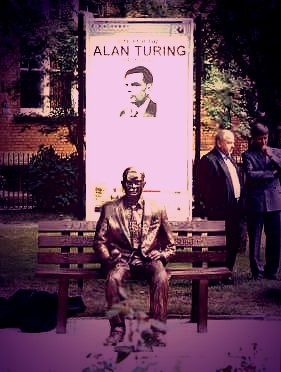
"We recognize the lives, courage and work of those blessed souls who in significant ways furthered the cause of Homosexuality and who stand as shining examples to gay people everywhere through their lives and, tragically often also their deaths," Subia added. "While not all were gay themselves, we proclaim them Saints and Martyrs as an example to all who believe in the sanctity of Same-Sex Love," he said.
He said that Judy Garland, for example, helped shape Gay Identity in the 20th Century.
Subia expounded on the idea of a "Gay Religion" based on a Classical Roman God by saying, "The Religion of Antinous is a Truly All-Gay Religion, dedicated to homosexual spirituality. Our thousands of followers around the world are devoted to Antinous, who was a real person ... a beautiful youth loved by the Roman Emperor Hadrian in a relationship which was openly homosexual."
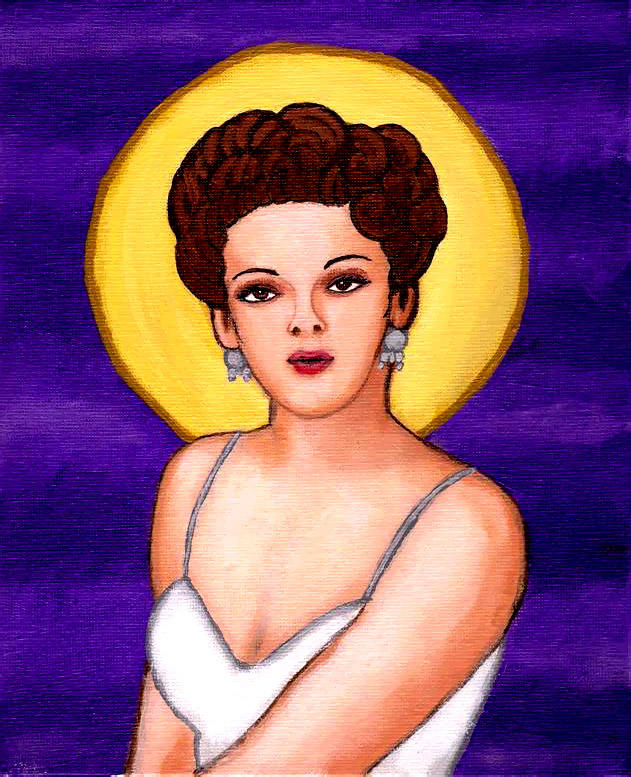
During an Imperial tour up the Nile, Antinous mysteriously drowned in the River Nile. Hadrian is said to have "wept like a woman" at the loss. The grief-stricken Emperor declared Antinous a god after his death in the year 130 AD. Miraculously, the following year a drought ended in Egypt. Soon after, other miracles were attributed to Antinous. Lowly born himself, Antinous was seen as a promise of divinity for slaves and plebs. His priests were renowned for religio-magical prowess.
"Hadrian spread the Religion of Antinous around the Roman world," Subia related, "promoting Antinous as the savior of the world, and the bringer of peace."
The Hollywood Temple of Antinous is devoted to the rebuilding of the ancient Religion of Antinous, but rebuilding it in a manner which meets the spiritual needs of gay men in the 21st Century. The religion was revived in 2002 and now has an active membership of nearly 500 persons, in addition to thousands who visit the Temple of Antinous website on a daily basis, according to Subia, an artist with stage production and musical performance background.
"Homosexuality is Sacred, and Antinous is the manifestation of the Divine Gay essense," said the Hollywood gay priest. "Through love of our own kind, we are made aware of self-love, and the origin of celestial love...and with that Sacred Secret in our hearts, we are made divine, through the grace and beauty of Antinous."
The Emperor Hadrian was so grief-stricken at the death of his beloved male lover Antinous that he founded a city in honor of Antinous ? called Antinoopolis ? on the shores of the Nile where Antinous died. The city was founded on October 30th, which is when the sainthood ceremonies for Judy Garland and the other new saints were held.
Antonyus Subia's painting (above) is inspired by the YouTube video below:
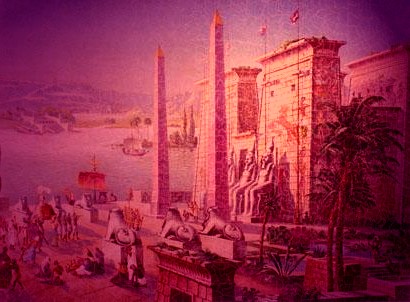
On October 24th the Religion of Antinous enters the holiest and most mysterious part of our religious year ? The Sacred Nights of Antinous, which continue through November 1st.
We are commemorating the tragic death of the Beauteous Boy and his miraculous deification and the glorious founding of his Sacred City of Antinoopolis and the birth of a religion which had (and will have) millions of adherents.
Come with me as we head down the dark stairs beneath the Great Temple of Antinous ? down, down, down through musty and dank corridors to the place where, on October 24th, we remember The Passion of Osiris, which is the creation of godhood from death.
These Sacred Nights ceremonies take place in utter darkness in the deepest and most secret part of the Great Temple of Antinoopolis. A few years ago Arch Priest Antonyus Subia wrote a detailed description of the Great Temple, including the catacombs where these ceremonies take place in the depths of the temple:
"...and then the tunnels wind down past little side chambers dedicated to secret gods with attendant priests to watch over little black covered altars...and at the lowest level is the Chamber of Antinous the Death Prince and Our Lady Death.
"It is a round vaulted room ... with a Romano-Egyptian theme ... in the large main niche is a colossal Antinous-Osiris standing on a golden Nile-barge ... and seated at his feet, on a golden throne, would be a life-size statue of Nuestra Senora La Santissima Muerte, holding her pomegranate.
"The walls of the chamber would be circled by the tombs of the Ancient Priests of Antinous, mummified of course, and encased in standing glass coffins, dressed in golden togas and gold wreaths with their heads turned towards Antinous, so that they can look upon him for eternity.
"And every surface of the walls is covered with thousands of little niches filled with little silver urns holding the ashes of all the believers who had earned the honor to rest, for all time, near the sacred boat of millions of years.
"And in the center of the chamber would stand an image of Hadrian, facing Antinous, dressed as an initiate of the Mysteries of Eleusis. THIS is where the Sacred Nights take place ... in the lowest and most horrifying part of the temple."
Here, in the deepest and darkest and scariest part of the Great Temple, we prepare to commemorate The Sacred Nights, which start with the initiation of Hadrian and Antinous into the Mysteries of Hermes/Thoth in the great city of Hermopolis on the banks of the Nile. It was Hermes/Thoth who imparted the Sacred Words (which is what "hieroglyphs" means) and magical spells to the goddess Isis by which she raised Osiris from the dead to ever-lasting life as a god.
On October 24th Antinous and the Imperial entourage were in the ancient city of Hermopolis, the Sacred City of Thoth/Hermes during the celebration of the Death and Resurrection of Osiris. It is believed that the spiritual forces of this occasion, and the Mysteries divulged to him by the Hermetic priests of the god Thoth, were the inspiration for this ascension into godliness.
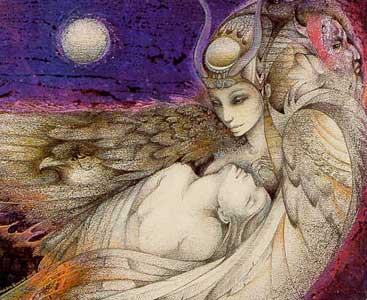
The story is that Osiris and Isis ruled Egypt as wise monarchs and that Osiris taught humans how to till the fields and harvest crops by using irigation water from the Nile. Osiris was loved by all mortal humans, which made his brother Set Lord of the Deserts, so envious that he decided to murder Osiris.
He gave a banquet for Osiris and, after getting Osiris very drunk, he suggested a game in which he and his brother would play a kind of hide-and-seek using large ornate boxes ? coffins, really. He offered Osiris one box to hide in, but it was too small, so Osiris climbed into another, which was the perfect size. But before he could get out, Set and his henchmen sealed up the box and threw it into the Nile, where it was carried away, off out into the "Great Green" (as the Egyptians called the Mediterranean) and where it washed ashore in a foreign land.
Isis immediately set out, using the magical spells she had learned from Hermes/Thoth. After many adventures, she found the coffin with Osiris inside. Isis returned from Phoenicia (others say Lebanon) with the sarcophagus containing the body of Osiris. With the magical spells of Thoth's Scroll of Life (which features prominently in so many mummy movies), and with the keen senses of her faithful step-son, the jackal-headed Anubis, she embalmed the dead body to a semblance of life.
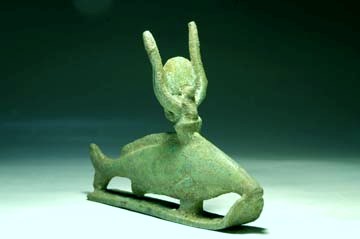
Set, however discovered that the body of Osiris had returned to Egypt and, together with his seventy-two henchman accomplices, he attacked the body and tore it into pieces, scattering the fragments up and down the valley of the Nile, like the seeds that are scattered over the fields when the Nile recedes.
Isis once again set out in search of the pieces. She found everything except the penis, which had been swallowed by the oxyrhynchos fish, which is why the oxyrhynchos fish has a penis-shaped snout and is why even to this very day Egyptians refuse to eat the flesh of this fish, because it is sacred.
With the skillful hands of Anubis and with the magic spells of Thoth, she was able to restore Osiris to wholeness. She even created a magical phallus which is eternally erect.
Isis is not called the Great Sorceress for nothing!
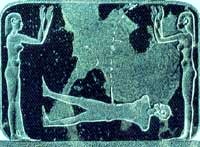
She transformed herself into a bird and so adeptly stimulated Osiris so that he ejaculated the magical "Semen of the First God" into her ? in other words, she could make a dead man come, she was so hot.
Thus, hovering over the body in the form of a bird, she became impregnated with Horus who would avenge his father at the hands of his brother Set.
There are many versions of the Passions of Isis and Osiris. In one version, a version I especially like, Isis leaves the baby Horus in the care of the blessed scorpion goddess Selket, whose attendant scorpions fight off anybody and anything that comes near the baby, while Isis is off raising her husband from the dead so that he will be the Lord Of All Things Which Live and Die and Which Live Again For All Eternity.
The Passions of Isis and Osiris were played out annually in Ancient Egypt and formed the cornerstone of the Egyptian belief system ? you could die horribly and tragically and yet you could be revived and restored and in fact you could become a god.

The festival of Osiris celebrated at Hermopolis and observed by Hadrian and Antinous commemorated the rending of the body of Osiris and the searching of Isis for each of the parts.
We believe that something of a cathartic nature happened within the soul of Antinous on October 24th. For it was only a few days later that he plunged into the Nile on the opposite bank across from Hermopolis. We will never know precisely what happened. Did Antinous get a glimpse at the fabled Scroll of Thoth? Did some Egyptian magician-priest teach him a bit about spellcasting? Did Antinous perhaps believe that he could use a spell to prolong Hadrian's life?
The Egyptians believed anyone who drowned in the Nile would become "a deified Osiris". Some Egyptian magical spells call for the magician to "deify a scarab beetle" ? which means to drown it in Nile water and thus make it sacred and magical.
We will never know for sure what happened as a result of the ceremonies on October 24th.
Arch Priest Antonyus tells us:
"Like Osiris, Antinous descended into the Nile, and arose to bring the blessing of eternal life to the world. The Religion of Antinous, like the body of Osiris was scattered over the face of the world, and we who worship him, are like Isis, gathering the fragments together again.
"Hermopolis was the last city that Antinous ever saw, and the Passion of Osiris was the last religious ceremony in which he took part. Certainly it was here and at this time that an Awakening occurred, dark in its implications, causing Antinous to relinquish his life.
"But it was of splendid power in that, from the death of the boy, a god emerged. We observe that in Hermopolis, the scattering of the body of Osiris was the moment when the sperm of the blessed one was planted in the immortal spirit of Antinous, Our God."
The Sacred Nights of Antinous continue ....

On October 11th, the Religion of Antinous commemorates the Imperial entourage's arrival in the fabled Egyptian city of Oxyrhynchus the city named for the fish which swallowed the Phallus of Osiris.
Forgotten by everyone except Egyptologists today, Oxyrhynchus was the third-largest city in Egypt (after Alexandria and Mennefer/Memphis) when Hadrian and Antinous visited it in October of the year 130 AD ? only a matter of days before Antinous drowned a few kilometers upstream from this city.
For more than 1,000 years, the inhabitants of Oxyrhynchus dumped garbage at a series of sites out in the desert sands beyond the town limits. The fact that the town was built on a canal rather than on the Nile itself was important, because this meant that the area did not flood every year with the rising of the river, as did the districts along the riverbank.
When the canals dried up, the water table fell and never rose again. The area west of the Nile has virtually no rain, so the garbage dumps of Oxyrhynchus were gradually covered with sand and were forgotten for another 1,000 years ? it is that phenomenon which meant that priceless documents came down to us virtually intact.
It is of course an irony of history that the documents which came down to us were the "cast offs" and "rejects" from the libraries in Oxyrhynchus ? they were the documents which were thrown out to make room for more important documents ? which presumably were put to the torch by Moslems in later centuries.
Our own ANTONYUS SUBIA writes about that fateful visit:
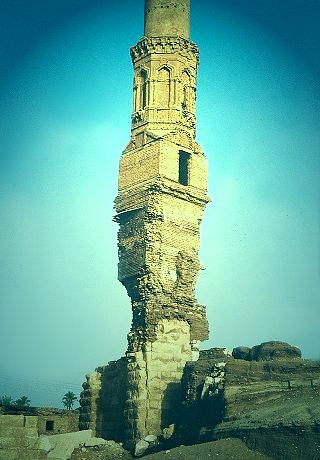
"Antinous entered the city of Oxyrhynchus, a Greek city founded by the Ptolemies, that has since become famous for the thousands of papyrus fragments unearthed in its buried libraries.
"The people of Oxyrhynchus were highly literate and therefore made a welcome stop for the Greek-loving Emperor Hadrian. The visit of Antinous to this city is important because several fragments mention his name, and the sacred poem of the Sacred Lion Hunt was found here.
"We are reminded by Oxyrhynchus of the fragile nature of the written word and how easily knowledge can be lost, and therefore, we sanctify the memory of the city to the importance that these fragments confer about our God Antinous. The primary Goddess of Oxyrhynchus is Athena-Sophia, patroness of learning."
There were also Greek temples to Demeter, Dionysius, Hermes, Apollo, the goddess Fortune together with Roman temples to Jupiter Capitolinus and Mars.
Apparently, the city had many public buildings, as noted in the papyrii unearthed in the region, as well as places of worship. Though only traces remain, archaeologists have identified a theater, which could seat 11,000, a hippodrome where the traditional chariot races took place, four public baths, important because there was no running water available in private homes, a gymnasium, which was an important center of cultural life during the Hellenistic and Roman periods, and two small ports on the Bahr Yusuf canal.
It is also likely that there were military buildings, such as barracks, since the city supported a military garrison on several occasions during the Roman period ? a military installation which Hadrian no doubt visited.
Hadrian would have delighted in the city's libraries and temples. Antinous, like adolescents of all ages, no doubt was intrigued by the fact that Oxyrhynchus (Greek for "pointy snout") takes its name from a phallic-shaped fish which was worshiped by the Egyptians because it had devoured the severed penis of Osiris.
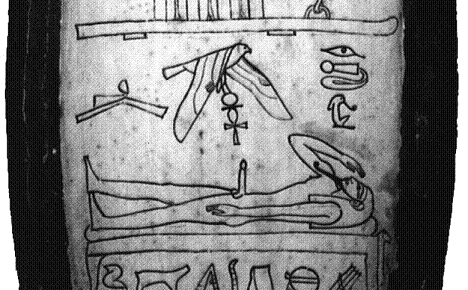
There are several versions of the myth concerning the Travails of Isis and Osiris. The Nile is a very long river, and each region seems to have had a local version of the tale of the Death and Resurrection of Osiris.
People in Oxyrhynchus told a version in which Seth, God of Chaos, murdered his brother Osiris and dismembered his body, strewing the various body parts up and down the length of the Nile.
Grieving Isis went in search of her lover's limbs, collecting them and reassembling them. She found every bit of him except for his penis, which had been imgested by the Oxyrhynchus fish, giving the creature a distinctly phallic shape.
To this day, some people in Egypt refuse to eat this fish, calling it unclean. Others, however, say its flesh lends potency and virility to men suffering from erectile dysfunction, or that women who eat of this fish will bear strong male children.
To search for the body parts, Isis enlisted the help of her sister Nephthys and Anubis (who is either the son of Nepththys and Seth or possibly the illegitimate son of Isis and Seth, depending on which version of the story you hear). Then she used magical spells over life and death (which she had tricked Ra into entrusting to Thoth, who then passed the spells on to her) and magically restored Osiris to everlasting life.

But she wanted a son to avenge Osiris, and so Isis fashioned a magical erect penis of electron (a gold/silver alloy of special magical properties) and transplanted it onto the loins of Osiris. Some say she transformed herself into a hawk and mated with the magical phallus. Others say her wiles were enough to cause a spontaneous ejaculation which sent semen gushing in great arcs.
Sacred Marionettes with enormous pricks were an important part of Egyptian sacred/magical ritual Passion Plays in Oxyrhynchus. Perhaps such a play was staged for the amusement of Hadrian and Antinous. The Greek historian Herodotus describes one such play about the Passion of Isis for her beloved Osiris. Herodotus uses the Greek name Dionysus in place of Osiris.
Herodotus writes:
"The rest of the festival of Dionysus is observed by the Egyptians much as it is by the Greeks, except for the dances; but in place of the phallus, they have invented the use of puppets one cubit high (two feet or 60 cms) moved by strings, the hinged male member nodding and nearly as big as the rest of the body, which are carried about the villages by women; a flute-player goes ahead, the women follow behind singing of Dionysus.
The semen with which Osiris sired Horus was no ordinary semen, of course. It was the "Semen of the First God".
Hadrian and Antinous would have heard a lot about the "Semen of the First God" during their travels through Egypt. A few days before they arrived in Oxyrhynchus, they had visited Heliopolis. That is the town near Mennefer (Memphis/Cairo) where the Egyptian magician/priest Pancrates gave to Hadrian (or rather sold to him at an exhorbitant price) a magical spell which could bind another man's affections to him forever ... when the spell was cast properly. If cast wrong, the spell would result in the death of the other man.
There was some speculation in ancient times as to whether the death of Antinous may have be related to this strange Egyptian spell. Whether you or I believe in the efficacy of Ancient Egyptian Spellcasting, Hadrian most certainly DID believe in magical spells (being the wise man that he was).
Let's assume Hadrian cast the spell a few days or weeks prior to the death of Antinous ? well, that would certainly explain his inordinate grief at the Blessed Boy's death and his penance in declaring Antinous a god ... perhaps out of a profound sense of guilt.

Historians have speculated on this point for centuries.
But back to the Phoenix of Heliopolis ? the Bennu bird who "Comes into Being by Himself". Hadrian and Antinous visited Heliopolis and were no doubt shown the sacred shrine of the Bennu bird, who was said to have burst forth in a shower of radiant light from the heart of the First God.
This is the same First God who ejaculated into his own mouth to utter the words of creation at the moment of Sep Tepy, the Creation Moment. Other versions say he ejaculated in great arcs which created all the other deities and the entire universe.
Then on October 11th, a few days after visiting the Sacred Shrine of the Phoenix in Heliopolis (and acquiring that virulent bit of spellwork), Hadrian and Antinous visited Oxyrhynchus and heard of the fabled phallus of Osiris.
And a couple of weeks later, Hadrian cradled the limp body of Antinous on the shores of the Nile. The body was limp like a marionette whose strings had been cut. Hadrian "wept like a woman" and refused to accept oblivion for his Beloved Boy. Instead, he proclaimed Antinous a god and set about making sure that the Religion of Antinous took root and blossomed.
The OBELISK OF ANTINOUS speaks of Antinous being full of the "Semen of the First God" which is the creative force of the universe. That means Antinous can assume "any form his heart desires" since he (like Osiris) is one with the First God ? and one with the Bennu Bird.
Antinous IS the Phoenix.

We have entered the most sacred month of our Liturgical Calendar, the month of October when Antinous the mortal died beneath the waves of the Nile during a tour of the Eastern Provinces which had started out as the crowning glory of the reign of Emperor Hadrian, but which quickly descended into disaster.
By the end of October, Antinous would be dead and Hadrian would be a changed man. Up until this turning point, his rule had been marked by Hellenistic tolerance and diplomacy. From this point onward, the emperor became increasingly capricious and unpredictable.Just imagine those last few weeks in September and October of the year 130. Hadrian and Antinous had visited Alexandria. They had marvelled at the towering lighthouse. Perhaps, in his youthful exuberance, Antinous had even scaled the lighthouse to get a spectacular view from the top.
They would have visited the Tomb of Alexander the Great and have marvelled at the rock crystal sarcophagus containing the body of the young man who had conquered the world by the time he was just a little over half Hadrian's age.
That's assuming the Tomb of Alexander was still located in Alexandria in the year 130. Like the Tomb of Antinous, no one knows the whereabouts of Alexander's Tomb.
That would have been a recurring theme during their travels through Egypt: The plundering of the tombs of Egyptian rulers.
Hadrian and Antinous would have gazed in awe at the Sphinx and the Pyramids, which were already incredibly old even then. The Great Pyramid was 2,500 years old THEN! (With apologies to John Anthony West who believes the Sphinx, at least, could be many thousands of years older than that.)
And those monuments had long since been plundered. The Sphinx had undergone "restoration" work more than 1,000 years before Hadrian and Antinous saw it.
At the Egyptian capital of Memphis, called Mennefer

Everyone scaled those cliffs to look out over the city and the Nile and the sprawling Temple of Ptah compound ? The House of the Ka of Ptah (Ha-Ka-Ptah), which was so famous, so synonymous with the Land of the Nile that it became the name used by tourists for the land itself: Hakaptah, Aegypto, Egypt.
It must have been spectacular. It must have been one of those things that all tourists do. In London you see Big Ben and the Tower. In San Francisco you see the Golden Gate. In Paris, the Eiffel Tower. In ancient Memphis Egypt, you climbed the western cliffs for the view across that marvelous city of gleaming-white temples and palaces.
The city is gone ? or rather, the city has been uprooted and moved, stone-for-stone a few miles down-river. Memphis, the capital of Egypt, never ceased to exist. It just morphed into Cairo.
The view from the cliffs is still spectacular. To the east is the verdant valley where the ruins of the once-mighty city lie strewn among date palm orchards. This is the city from which the name PHARAOH comes, PER-AWU (Two Great Gates). It refers to Pharaoh's palace double-doors, through which the Living God-King (Hadrian for example) emerged on occasion for the public to see.
To the west lies the desert and the city of the dead. You look across rippling sand dunes and stony mounds and your jaw drops as you realise those aren't sand dunes ? they are the remnants of tomb and mortuary monuments large and small, thousands of them stretching as far as the eye can see.
Like the Step Pyramid, many of those tombs had been plundered by the time Hadrian stood there, taking in the scene.
To the south lie the hot lands of the source of the Nile. Still more pyramids dot the horizon.
To the north, more pyramids and tombs. You can see the tips of the Great Pyramid and the two lesser Gizeh pyramids to the north, with a gentle and cooling north breeze blowing in your face.
You stand there in wonderment, oblivious to the urchins tugging your sleeve and trying to sell you bundles of filthy rags which they claim are "genuine old" mummified cats which you can take home as souvenirs.
You can just envision Hadrian standing there, enjoying the view of that bustling city and the ancient pyramids, and smiling to himself as he glanced over and saw Antinous trying to keep his composure while being badgered by children waving blatantly fake cat mummies in his face.
Just imagine Antinous standing there in the late-afternoon sun, the north breeze tousling his hair and robes, atop those cliffs on the cusp between the verdant land of the living in the teeming valley below and the sterile and barren city of the dead on the desert plateau behind him where the sun would soon set.

We commemorate this Imperial visit to Mennefer (Memphis) on October 5th. Shortly after that date, they would have sailed on upstream to the city of Shmunu (Hermopolis), the ancient and sacred city of Thoth, the scribe god of writing who taught Isis the magical spells that she used, with the assistance of Anubis, to raise Osiris from the dead after he drowned in the Nile.
It was only across the Nile from Hermopolis that Antinous himself drowned.
All of this would have been fresh in Hadrian's mind as the grief-stricken Emperor bent over the lifeless body of his Beloved Boy.
He would have remembered how even the Egyptians, despite all their cunning and ingenuity, had been unable to create a plunder-proof tomb.
Sick with grief, what would he have done? What would you do in Hadrian's place? Would you build a showy tomb? Would you send the body back to the boy's family for cremation? Would you build a chapel and tomb at your villa outside Rome? Would you leave the remains of his beloved Antinous to be mummified and entombed on the banks of the Nile?
Wouldn't the prospect of thieves and souvenir-seekers violating his remains be so horrible to you that you would do whatever was required to prevent that? Perhaps Hadrian opted for subterfuge.
Perhaps he built great temples to Antinous for all to visit and to see. But buried his precious body in a secret place, a safe place, known only to himself. A place where no one would think of looking for him.
If that is what Hadrian did, then the LOST TOMB OF ANTINOUS may never be found.
A fast-moving black spider appeared on Pope Benedict XVI's white robes as he addressed politicians and diplomats in Prague this past weekend, quickly crawling up his left sleeve and then around the back of his collar, down his right sleeve and back up it again.
The pope didn't notice it until it scuttled up the side of his face and nestled in his ear, so that he swatted at it. To give it the brush-off.
But the wily spider evaded death by casting a strand of spider silk and leaping out of harm's way. As the pope left the hall, the spider was seen dangling from that silken strand.
I would like to think it was a newly-hatched baby Antinous Spider (a wily jungle creature known as a very fast runner) and it was trying to whisper some words of admonition in the papal ear. An itsy-bitsy Antinous Spider.
Like our Religion of Antinous, the baby spider is as yet still very small ... but it is growing ... and growing ... and growing ....
One day it will be too large to be brushed off casually with the flick of an aged papal hand.
If you do a Google search for "Antinous", you find entries for a South American spider known as the Antinous Tarantula ? Pamphobeteus antinous, the zoological name for which refers to The Beloved Boy. The Indios have many other names ? such as Blue Legged Bird-Devourer.
It is native to the lofty rain forests of Peru and Bolivia and is known for its ferocity and for its consumption of small birds and other hapless creatures asleep and defenseless when it prowls at night. It runs and pounces very fast and surprises its prey unawares. It has no fear of humans and charges at people, hurling venomous hairs from its bristly legs and body. In captivity, it lunges against the glass walls of its prison when humans peer too closely. Its bristles are toxic even after death.

It was named the Antinous for its stunning, two-tone iridescent legs (photo above) and its breathtaking size. The male's leg span is as big around as a man's hand with outstretched fingers. Even the female Antinous Tarantula is frightfully impressive, though only half the size and far less colorful (photo right).
For those of us who recoil at the sight of a tiny household spider, it seems grotesque to name a huge, hairy, venomous, bird-eating tarantula for a god who embodies the perfection of male beauty, love and sensuousness.
But for arachnid collectors, the Antinous Tarantula truly is the most beautiful of spiders, living up to its name. The Antinous Tarantula is the prize specimen in any spider expert's collection. It is the eight-legged embodiment of arachnid pulchritude ? at least in the eyes of biped arachno-maniacs who scour the South American mountain rain forests in search of this elusive beauty.
In 2007, two French arachnidologists survived for seven weeks in the Amazonian jungle on a diet of bird-eating spiders, which they had captured as lovely specimens but which they (very reluctantly) were forced to eat.
For Indios, the Antinous Spider is a jungle delicacy. A big male tips the scales at half a pound in weight (250 grams). They cook them over a fire with their legs tied together, plunge them in hot water to remove the harpoon-like hairs, cut them up and eat the soft parts. Spider omelette is a favorite ? Indios squeeze out the eggs onto a leaf and smoke them over a fire. Thus, two spider collectors survived on the upper Amazon. That is a lesson in beauty (and nutrition) in the jungle.
For us Antinoians, the SPIDER OF ANTINOUS is more than just a zoological specimen, just as the RED LOTUS OF ANTINOUS and the STAR OF ANTINOUS are more than just botanical or astronomical entries in a textbook. All three figure prominently in the belief system of this new/old religion.
The three ? the Flower, the Spider and the Star ? represent the three stages of initiation into the worship of Antinous which ANTONYUS SUBIA has spelled out in the Ecclesia Antinoi Charter.

The Flowers of Antinous are the many people who join ECCLESIA ANTINOI with an avid interest in Antinous and who draw artistic and intellectual inspiration from Him, but who don't necessarily believe in His divinity. That doesn't make them any less beautiful or precious, for without them, there is no Religion of Antinous. Millions appreciate Antinous as the epitome of divine male beauty which, after 1,800 years, is remarkable in itself.
But there are deeper and far darker secrets for those who become ensnared in the web of the SPIDER OF ANTINOUS. They are those of you who have (perhaps years ago) expressed your belief in ANTINOUS and who become citizens of the SACRED CITY OF ANTINOOPOLIS. You have put yourself in His web. You believe in Him and are awe-struck by him. And as you lie there in His web, perhaps unsure or even a bit fearful about what comes next, you look up through the rain-forest canopy and see your final destination shining darkly in the black nighttime sky.
You see the STAR OF ANTINOUS, which is your own ultimate self. You become one with Antinous ? HOMOTHEOSIS ? becoming aware of your true sacred nature.
Arch Priest Antonyus expresses it very beautifully:
There are many FLOWERS OF ANTINOUS, and of these, many, when they become aware of Antinous Consciousness, if I may use such a term to describe His touch, or the burning of His flame, are immediately ensnared in the confusion of the web of the SPIDER OF ANTINOUS. But few are they who have found the power of the Liberator, who restores the fragrance of the FLOWER and opens its petals to the unseen light of the STAR OF ANTINOUS. I would say that those who have found their way back ... return with new eyes ... able to see the light that vanished from the sky ... which is why I call the Holy Star of Antinous the BLACK STAR.
So when you look upon this awesome spider ? "awesome" in the original sense of the word, which means "scary" ? may you think of the spiritual road upon which all of us have embarked. From the spiritual blossoming of the FLOWER OF ANTINOUS to the ravenous spiritual hunger of the SPIDER OF ANTINOUS to the heavenly spiritual shining of the STAR OF ANTINOUS.

The residents of the strife-torn city of Alexandria had rarely seen the pomp and splendour which greeted their eyes on September 21st of the year 130 AD when the Imperial Entourage of the Divine Hadrian boarded a flotilla of splendidly outfitted barques and departed the city to sail up the Nile on the final leg of the Emperor's Grand Tour of the Eastern Provinces.
Quite frankly, most Alexandrians were rather happy to see the Roman visitors depart. The fundamentalist Jews and radical Christians could get back to torching each others' neighborhoods. And the snooty Greco-Egyptian elite could get back to pretending to be superior to the upstart Romans. Now they could gossip openly about Hadrian and his gorgeous male lover Antinous. Not that they hadn't gossiped out of earshot of the Imperial coterie during the two-month visit ? albeit not too far out of earshot that the Imperial party did not understand what was going on.
Hadrian must have been relieved to leave teeming Alexandria with its eternally fawning and eternally scheming dignitaries and its rabble-rousing religious factions. He and Antinous had visited the Great Library and they (probably) had visited the Tomb of Alexander the Great. But they could not go anywhere without bodyguard protection and mounted soldiers to keep a notoriously volatile and riot-prone populace at bay.
But now, at last, from the comfort and safety of their flotilla of river barques, they could sail up the Nile and visit all the ancient wonders of Egypt ? the Sacred Temple of the Sun at Heliopolis, the Pyramids, the great white-walled city of Mennefer (Memphis), the Sacred City of Hermes/Thoth at Hermopolis where the Sacred Scroll of Life was said to be kept. There were so many wonders awaiting them ....
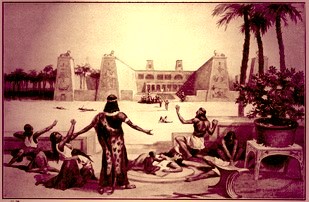
For young Antinous, the trip must have been unimaginably wondrous. Enormous monuments dwarfing anything, even in Rome itself. Temples and statues to animal-headed gods. Priests chanting magical spells in a language so ancient that even the priests themselves scarcely understood the glyphs on the brittle magical scrolls.
For the Romans, Egypt was a land of mystery and magic. While the Romans prided themselves on a history stretching back some hundreds of years, the Egyptian Civilization could be traced back for thousands of years. The Great Pyramid was over 2,500 years old when Hadrian and Antinous saw it in the year 130. And it was apparent the Egyptian civilization had flourished for countless centuries before that monumental achievement.
The Romans were well aware that the Egyptians had built monolithic monuments of stone and had ruled a vast empire when Rome was just a collection of mud huts nestled under seven protecting hills along the Tiber.
Yet, regardless what disparaging things the snobbish Grecophile elite in Alexandria might say about the Roman Emperor, it was clear that the peasants who waved and cheered to the Imperial flotilla from both sides of the Nile viewed him as a Living God ? as Pharaoh. They were desperate. A years-long drought had left Egypt starving. And because Egypt was the breadbasket of the empire, the famine in Egypt was a strategic threat to the political stability of the Roman Empire itself.
The peasants looked to their "Pharaoh" with hope and yearning ? for a Divine Miracle. They were starving. Their fields were parched. Their children and livestock were dying. They saw the Imperial flotilla passing by their shorefront doorsteps and they raised their hands and their voices in a gesture that was half joy and half desperation.
Imagine the emotions which swept over the Emperor and his coterie of perfumed and manicured courtiers as their boats sailed past one village after another, each a bit more wretched than the last as they sailed upstream, where the drought was increasingly extreme. Mothers held their filthy, squawling babies aloft in hopes of a blessing from these passing gods. Young boys swam out from shore to welcome the boats, smiling and raising their hands out of the water in the age-old beckoning gesture for someone to hurl a coin their way.
The middle-aged Emperor was ill by this point in the journey and these unsettling scenes of strife, squalor and suffering differed greatly from the scenes of jubilation which had greeted his eyes in Athens and other cities on this latest tour. A Grand Tour which had started out in triumph was quickly becoming an embarrassing political fiasco. This was a turning point in the reign of Hadrian, a turning point which would reach its climax with the Death of His Beloved Antinous. He would never recover. The Roman Empire would never be the same. His rule of tolerance and diplomacy would give way to vengeance and capriciousness.
But in September of the year 130, everyone was looking to Hadrian for a miracle. Antinous must have sensed Hadrian's anguish and frustration. This impressionable young man perhaps wondered what he could possibly do to help bring about the much-sought miracle. He knew what lay at stake. The Empire lay in the balance.
Antinous had seen so many strange and wonderful new things. He had learned so much on this journey. He was just perhaps beginning to realize that each man has a spiritual destiny. He had seen Jews, Christians, Animists, Baalists, even a few followers of very exotic faiths from India and points even further east.
In Alexandria, Antinous had encountered a Christian sect leader with a very provocative thesis. Our own Arch Priest Antonyus Subia picks up the tale:
"The Gnostic Father St. Carpocrates was in Alexandrian when the Imperial court arrived. His doctrine of Freedom and Libertinism would come to flower shortly after the death and deification of Antinous.
"St. Carpocrates taught that we were all equal to the gods, but that we do not remember our divine origin. The process of self-deification involves exposing ourselves to the angels who ruled over forbidden things so as to be free from their control.
"Homosexuality was considered sacred by Carpocrates because it is a form of love fundamentally free from the process of regeneration. St. Carpocrates possessed a copy of the Secret Gospel of Mark, which contained a passage from the life of Jesus in which the Savior reveals the Kingdom of Heaven to a boy by laying naked with him.
"While in Alexandria, we believe that Antinous blessed and inspired the young Carpocrates to spread his new philosophy to the world. We observe this moment of transfiguration as the mutual consecration exchanged by Antinous the God and Carpocrates the Gnostic, while Hadrian's entourage boarded the fleet of ships and departed from Alexandria.
"Carpocrates blessed the Sacred Boat as Antinous stepped aboard. The profundity of the Carpocratian message is the heart of the Salvation of Antinous."
On September 21st, the Imperial entourage set sail in a fleet of gilded ships that would carry them up the Sacred Nile. We can only speculate at the thoughts that flowed through the mind of Antinous, tortured by the pain he saw in his Beloved Emperor/Lover and by the revolutionary spiritual idea of "man-godliness-becoming-the-same", which we call HOMOTHEOSIS. Again, Arch Priest Antonyus picks up the tale:
"Antinous and Hadrian assumed their places on the sacred boat from which, later, Antinous would take his plunge into godliness. This Ship is what we call the Boat of Millions of Years, a symbol for our religion, and an illustration of the ever-lasting Heaven of Antinous, which is a journey across the river of the Milky Way, toward the Black Star of Antinous."
Ironically, the first miracle attributed to Antinous the Gay God occurred the following summer, in the year 131, when the Nile overflowed its banks generously, watering the parched fields and creating plentiful bounty ? answering the prayers of starving millions. It was proof positive to hungry people throughout Egypt, throughout the Empire, that the drowned youth Antinous WAS most assuredly Divine!

ALL RIGHTS RESERVED
PERMISSION MUST BE GRANTED BY THE AUTHOR FOR USE ELSEWHERE